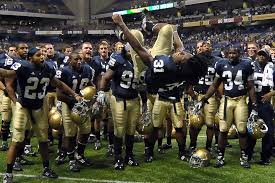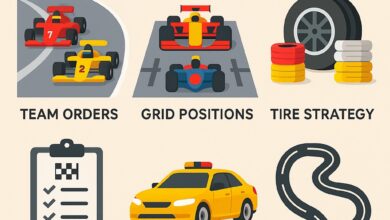Historic Moments That Shaped Notre Dame Football’s Legacy

Over a hundred years of football leave a lot of memories. But only a few become turning points. For Notre Dame, those moments from the muddy fields of the 1920s to the glare of today’s playoff stage.
Each one brought a strategic edge, a shift in national perception, or a result that changed the trajectory of the program. Let’s walk through the moments that shaped that lasting legacy.
The 1924 Four Horsemen Backfield
Notre Dame’s first big leap into national fame came in 1924. Coach Knute Rockne built a backfield with Harry Stuhldreher, Don Miller, Jim Crowley, and Elmer Layden. Their timing was sharp and their reads were clean. Defenses struggled to keep up. The Irish went unbeaten and won the national title.
Sportswriter Grantland Rice called them the “Four Horsemen.” The label stuck and turned into a lasting identity. Sharp execution, creative playcalling, and smart media use set the program’s standard. That base carried real weight in the decades that followed.
The impact of that season still reaches into modern Saturdays. The way the Four Horsemen dominated opponents helped set expectations for what a winning Notre Dame team should look like. That’s why, even in the build-up to today’s big matchups, fans and analysts study every angle before kickoff. They watch practice reports, track injuries, and check the latest Notre Dame Fighting Irish odds to see how the current squad stacks up.
The tradition built in 1924 still frames how people measure the Irish’s chances, whether it’s for a mid-season rivalry game or a playoff push.
Rockne’s 1928 Win Over Army
Just four years later, Rockne again showed why he was more than just a tactician. He was a master of the psychological game. Facing a heavily favored Army squad, he delivered the now-legendary “Win One for the Gipper” speech at Yankee Stadium. The result was a 12–6 upset that restored momentum to the Irish program.
This victory was more than a score on the board. It showed Notre Dame could outthink and outmaneuver any team, no matter the challenge. That kind of edge became part of the program’s DNA.
The 1946 Game of the Century
Fast forward to 1946, and Notre Dame found itself in another high-stakes showdown against Army, this time with both teams undefeated and stacked with future NFL talent. Over 70,000 fans packed Yankee Stadium to watch a defensive masterpiece end in a 0–0 tie.
Far from being a disappointment, the result preserved the Irish’s unbeaten record and propelled them to a national title. The game proved that Notre Dame’s disciplined, mistake-free approach could stand up against the best, a lesson that future coaches would continue to embrace.
It also reinforced the importance of controlling tempo in high-pressure situations, something that became a program hallmark. The matchup is still studied today for its defensive tactics, especially how the Irish contained one of the most explosive offenses of the era without giving up a single point.
Lou Holtz’s 1988 National Championship Run
In the late 1980s, Notre Dame needed a new spark, and Lou Holtz provided it. His 1988 team steered a brutal schedule and delivered in the season’s biggest moments, none bigger than the one-point win over Miami in the “Catholics vs. Convicts” game.
Holtz’s adaptability, blending a dynamic run game with a relentless defense, led to a Fiesta Bowl victory over West Virginia and a perfect season. This championship bridged the gap between the program’s mid-century dominance and the modern era, proving the Irish could still rule in a faster, more physical game.
The 2020 College Football Playoff Appearance
The 2020 season brought major changes. Pandemic scheduling moved Notre Dame into the ACC for one year. That shift created unfamiliar matchups and two high-profile games against Clemson.
In the regular season, the Irish beat Clemson in double overtime. That win ended the Tigers’ long conference streak and put Notre Dame on track for a playoff spot.
They made their second College Football Playoff appearance, though Alabama proved too strong in the semifinal. The season still showed that Notre Dame could adjust to new challenges and compete at the top level.
Runs like that draw heavy attention. Each week, fans follow matchups, track player stats, and debate playoff chances. To see where a team stands on the broader picture, fans refer to FanDuel’s Latest NCAAF Matchups to see scores, analysis, and context for every major game. The 2020 run was shaped not only by the results on the field but also by the constant flow of updates and discussion around the sport.
Marcus Freeman’s 2023–24 Bowl Breakthrough
The latest chapter came under Marcus Freeman, whose early seasons featured growing pains but also glimpses of promise. In the 2023–24 campaign, the Irish closed with a decisive New Year’s Six bowl win. They controlled the tempo offensively and smothered a high-powered opponent defensively.
This win was more than a milestone for Freeman. It signaled that Notre Dame’s next chapter could stand alongside the best in its history. It reminded fans of earlier turning points when one result changed the direction of a season and a program.
How the Bar Gets Measured in South Bend
Legacy here translates to measurable tests. Beat elite teams on neutral fields and in tough road environments. Stack strong Novembers to control ranking math. Turn showcase Saturdays into leverage for polls and postseason seeding. When those boxes get checked in the same season, the program’s trajectory spikes. That’s the operating model, not a one-off formula.



